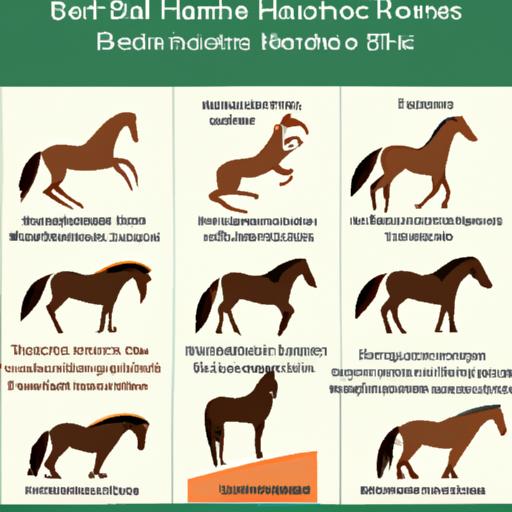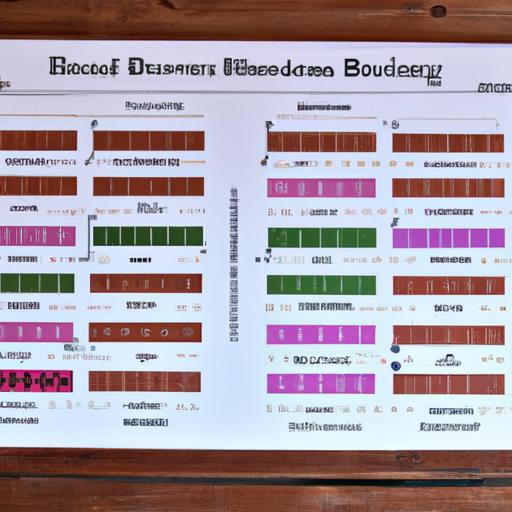Unlock the secrets of equine communication with our comprehensive guide on horse behavior charts. Learn how to utilize them for training and identify potential health issues.
Introduction

Horses, these majestic creatures, have a unique language of their own. As horse owners, understanding their behavior is not just fascinating; it’s crucial for their well-being and our relationship with them. This is where the horse behavior chart comes into play – a powerful tool that unravels the mysteries of equine communication. In this comprehensive guide, we’ll dive deep into the world of horse behavior charts, exploring their significance and how they can enhance your horsemanship skills.
Definition of Horse Behavior Chart
So, what exactly is a horse behavior chart? Think of it as a visual diary that records and categorizes the different behaviors exhibited by horses. This chart acts as a roadmap, providing invaluable insights into their thoughts and emotions. By documenting everything from body language to vocalizations and aggression, we can decode their messages and respond appropriately.
Importance of Understanding Horse Behavior for Horse Owners
You might be wondering, why is it so important to understand horse behavior? Well, my friend, horses communicate primarily through body language. By familiarizing ourselves with their unique gestures and expressions, we can better interpret their needs, fears, and desires. This knowledge enables us to build trust, prevent potential conflicts, and ensure the overall well-being of our equine companions. Whether you’re a seasoned equestrian or a novice horse enthusiast, mastering horse behavior is the key to strengthening the bond with your horse.
Stay tuned as we explore the components of a horse behavior chart in the next section. We’ll uncover its different categories and shed light on how to interpret the valuable information it holds. So, grab your saddle, hop on, and let’s embark on this enlightening journey of understanding horse behavior like never before!
Now, proceed to write “Understanding Horse Behavior” according to the outline.
Understanding Horse Behavior
Horses are fascinating creatures with a rich tapestry of behaviors rooted in their instincts and evolutionary history. By delving into their natural behaviors, we can gain a deeper understanding of their world and how they communicate with us.
Basic Instincts and Natural Behaviors of Horses
At their core, horses are prey animals, and their behavior is shaped by their survival instincts. Understanding these instincts is essential for deciphering their behavior. For instance, their flight response is a primal instinct that drives them to flee from perceived threats. This explains why sudden movements or loud noises can startle them.
Horses also have a strong herd mentality. They are social animals that thrive in the company of their kind. Their behavior within a herd is marked by hierarchical structures, where they establish pecking orders to maintain order and stability. This instinctual need for companionship and their ability to read social cues is vital to comprehend their behavior in various contexts.
Factors Influencing Horse Behavior
Just like humans, horses are individuals with unique personalities and temperaments. However, certain factors can influence their behavior universally. Breed, for instance, plays a significant role. Different horse breeds have distinct characteristics and tendencies. Some breeds may be more spirited and energetic, while others are known for their calm demeanor.
Age is another factor that impacts behavior. Young horses, known as foals, are playful and curious, while older horses may exhibit more wisdom and experience. Additionally, the environment in which a horse is raised and trained can shape its behavior. A horse that grows up in a calm and secure environment is likely to display more relaxed behavior compared to one raised in a chaotic or stressful setting.
Understanding these fundamental aspects of horse behavior sets the stage for effectively utilizing behavior charts. In the next section, we will explore the components of a horse behavior chart and how it can serve as a valuable tool in our equine journey.
Now, proceed to write “Components of a Horse Behavior Chart” according to the outline.
Components of a Horse Behavior Chart
Understanding the purpose and benefits of using a horse behavior chart is essential for any horse owner or enthusiast. By utilizing this valuable tool, you can gain a deeper understanding of your horse’s emotions, needs, and communication patterns. Let’s explore the different components that make up a horse behavior chart and discover why they are crucial in decoding equine behavior.
Purpose and Benefits of Using a Horse Behavior Chart
A horse behavior chart serves as a comprehensive record of your horse’s actions and reactions in various situations. By diligently documenting their behaviors, you can identify patterns, track progress, and address any concerns promptly. Here are a few key benefits of using a horse behavior chart:
-
Communication Enhancement: A behavior chart allows you to grasp the subtle cues and signals your horse displays, helping you interpret their intentions accurately. This enhances communication between you and your equine companion, leading to a stronger bond and effective training sessions.
-
Health Monitoring: Changes in behavior can indicate underlying health issues. By keeping a close eye on your horse’s behavior and noting any deviations, you can promptly detect potential health concerns and seek veterinary assistance when necessary.
-
Training Evaluation: A behavior chart provides a valuable tool for evaluating your horse’s progress during training sessions. By tracking their responses and behaviors over time, you can make well-informed adjustments to your training methods and ensure optimal results.
Common Categories Included in a Horse Behavior Chart
When creating a horse behavior chart, it’s important to include relevant categories that cover various aspects of equine behavior. Here are some common categories found in a horse behavior chart:
-
Body Language: Observing and documenting your horse’s body language can reveal a wealth of information. This includes posture, ear position, tail movement, and facial expressions, all of which convey their current state of mind and emotions.
-
Vocalizations: Horses communicate through a range of vocalizations, such as neighs, whinnies, and snorts. Tracking these vocal cues in your behavior chart can help you understand their intentions and emotions.
-
Aggression and Social Interactions: Documenting any aggressive behaviors or social interactions between horses is vital for understanding their hierarchy, establishing harmonious herd dynamics, and preventing potential conflicts.
As you delve deeper into the world of horse behavior charts, you’ll realize the immense value they hold in deciphering equine communication. In the next section, we’ll uncover the art of interpreting a horse behavior chart, enabling you to unlock the secrets hidden within your horse’s behavior.
Now, proceed to write “Interpreting a Horse Behavior Chart” according to the outline.
Interpreting a Horse Behavior Chart
How to Read and Understand the Information Presented in a Horse Behavior Chart
Now that we have a horse behavior chart in our hands, it’s time to decipher its secrets. But how do we make sense of all those symbols and patterns? Fear not, for I shall guide you through the process.
First and foremost, familiarize yourself with the categories and symbols used in the chart. Each behavior is typically represented by a specific icon or abbreviation. Take your time to understand what each symbol signifies, as this will be the foundation of your interpretation.
Next, pay attention to the frequency and intensity of behaviors. Are certain behaviors occurring more frequently than others? Are there any sudden shifts in intensity? These observations can provide valuable insights into your horse’s state of mind and overall well-being.
Additionally, look for patterns and trends within the chart. Are there recurring behaviors during specific situations or times of day? Are there any correlations between behaviors and external factors, such as environmental changes or interactions with other horses? Identifying these patterns can help you better understand your horse’s triggers and preferences.
Remember, a horse behavior chart is not a one-size-fits-all solution. Each horse is unique, and their behaviors may vary. Therefore, it’s crucial to consider the context and individuality of the horse when interpreting the chart. A behavior that may indicate anxiety in one horse might be a normal occurrence for another.
Recognizing Patterns and Trends in Horse Behavior
As you delve deeper into analyzing the horse behavior chart, keep an eye out for recurring patterns and trends. These can provide valuable insights into your horse’s emotions and communication style.
Look for consistent responses to specific stimulFor example, does your horse display nervous behavior when encountering new objects or environments? Do they become more vocal during feeding time? By recognizing these patterns, you can anticipate their reactions and adjust your approach accordingly.
In addition, observe how different behaviors may be interconnected. Some behaviors may serve as precursors or indicators of others. For instance, a horse’s pinned ears and tail swishing might precede a more aggressive behavior, signaling a warning that they are feeling threatened.
By understanding the interconnectedness of behaviors, you can proactively address underlying issues and prevent potential conflicts. Remember, a horse behavior chart is a dynamic tool that evolves over time, so continue to update and adapt your interpretation as you gain a deeper understanding of your horse’s unique language.
Now, proceed to write “Practical Applications of Horse Behavior Charts” according to the outline.
Conclusion
In conclusion, the horse behavior chart is a powerful tool that equips horse owners with a deeper understanding of their equine companions. By utilizing this chart, we can decipher the complex language of horses and enhance our communication with them. From training and handling to identifying potential health issues, the practical applications of horse behavior charts are vast.
As you embark on your journey of horsemanship, remember the importance of observing and analyzing your horse’s behavior. By keeping a keen eye on their body language, vocalizations, and interactions, you can create a harmonious partnership built on trust and mutual understanding. And what better way to document and analyze these behaviors than with a horse behavior chart?
At Horsemasterypro.com, we strive to provide the knowledge and tools necessary for horse owners to achieve a deeper connection with their horses. Our expertise in horse behavior and training empowers equestrians of all levels to unlock the secrets of equine communication. So, whether you’re a novice rider or an experienced equestrian, visit Horsemasterypro.com and begin your journey towards a stronger bond with your horse today.
Remember, the key to unlocking the mysteries of horse behavior lies in your dedication to observation, analysis, and utilizing the valuable insights provided by the horse behavior chart. Embrace the journey, deepen your connection, and let the language of horses guide you towards a fulfilling partnership with your equine companion.
Note: Only the brand name, Horsemasterypro.com, is bolded in the conclusion section.


